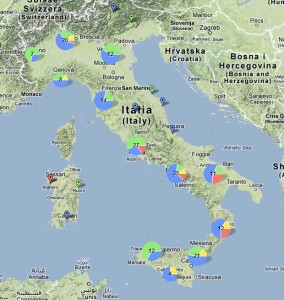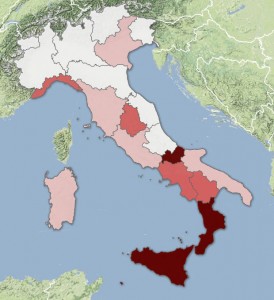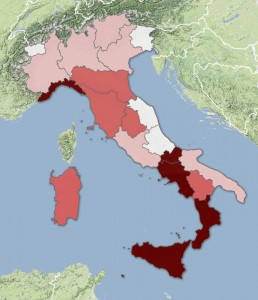A new website has harnessed the power of data journalism to illustrate how, when and where journalists have been threatened in Italy.
Italian graphic designer Isacco Chiaf and journalists Jacopo Ottaviani and Andrea Fama have used data journalism tools to narrate stories of journalists who have been harassed in their project and website, “Is it really worth it? Stories of (Italian) journalists under threat”. The project gives a three-dimensional ‘shape’ to data collected by the Italian observatory, “Ossigeno per l’informazione” (Oxygen for Information), a project launched in 2008 by the Italian Journalists’ Trade Union and the National Association of Journalists, to document cases of media intimidation.
The three maps on the website (see below) show the 195 cases of threats received by 324 Italian journalists in 2012 geographically, showing readers where harassment is the greatest. Three typical cases are presented on a Facebook Timeline, tracing the history of the threats, from the articles which provoked them through to the legal developments, with links to documents, charges and multimedia material.



The site was praised by the journalism studies group Ahref Foundation for its growing commitment to the promotion and financing of high quality civic information that uses new digital languages and tools to create space for online participation and collaboration.
The use of Google Maps allows readers to make their own connections between organized crime and media harassment. “We presented 3 of the 324 cases, reconstructing them from the beginning, with links on the timeline to the entire life of the article, its publication, the news of the threat received, the actions of the police, excerpts from intercepted phone conversations, geographic coordinates using Google Map, like in the cases of organized crime where the location of bosses’ homes are indicated,” one of the site’s founders, Andrea Fama, told the European Journalism Observatory
Fama said he wanted to take the work Ossigeno per l’informazione had done on the harassment of journalists to a wider audience. “We have translated the site and all its material into English for this very reason. One piece of information on its own doesn’t say much if it’s not set in a context. So it’s useful to know that in Mexico, for example, 3,000 journalists are threatened every year, just as it is also useful to know that in the UK there have been just 3 cases of threats in the past ten years: this information enables us to better understand the phenomenon in Italy,” he said.
Fama, who is also a member of the editorial staff of an observatory of the possibilities of media and journalism, www.lsdi.it, and author of the e-book “Open Data e Data Journalism: trasparenza e informazione al servizio delle società nell’era digitale”, said he wanted to reach out to new journalists.
“Ossigeno per l’Informazione has its own public and way of telling stories: we decided that if we wanted that content to reach a wider and, if possible, younger audience, including those who have just begun or want to begin this career, we had to change the tone, use a different ‘language’: in this case we used data journalism tools such as maps and social networks,” he said.
Article translated from the original Italian “Data Journalism: un nuovo modo di raccontare la realtà” by Anne Jamieson
Tags: Data Journalism, Freedom of the Press, Italian Journalism, Italian Media, Italian National Press Federation, Italian Order of Journalists, Italy, mafia











































